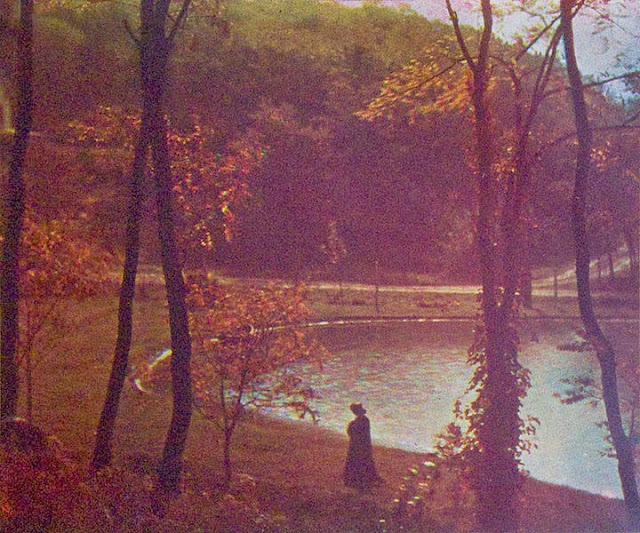 |
| Experiment in Three-Color Photography, 1906, Edward Steichen |
 |
Self-portrait with Brush and Palette,
1903, Edward Steichen |
Few artists can be said to have taken their art so far in a single lifetime as Edward Steichen. Of course, few artist have the opportunity to see and make such progress by living to be ninety-three years of age. Steichen was born in Luxembourg in 1879. At the time, photography was still using flash powder, and exposure times were measured in seconds, rather than
fractions of seconds. Steichen was still a baby when his parents brought him to America. They settled in Chicago in 1881. From there they moved to Milwaukee in 1889. Using a second-hand Kodak box camera Steichen took his first pictures in 1895. While still an apprentice for a lithography company, Steichen began to teach himself how to draw and paint. Fortunately, he was a better photographer than painter (bottom).
 |
| Moonlight: The Pond, 1904, Edward Steichen |
 |
Auguste Rodin, 1902,
Edward Steichen |
Steichen headed for Paris to study art in 1900, shortly after becoming a naturalized American Citizen. Stopping in New York for a day or two, he met Alfred Stieglitz, a photographer/artist very much like himself though some fifteen years older and much further along in his career. Stieglitz liked Steichen's work and began to advise, promote, exhibit, and publish the young photographer in his new photography journal,
Camera Works. Steichen even designed the journal's logo. He was also the major contributor to the publication. Shortly thereafter, the two men opened a number of Little Art Galleries, eventually consolidated into Stieglitz's groundbreaking Gallery 291 (its street address). Stieglitz and Steichen were the first in the U.S. to display works by Pablo Picasso, Henri Matisse, Auguste Rodin (left), Paul Cézanne, and Constantin Brâncuși.
 |
| The Flatiron Building, New York, 1904, Edward Steichen |
 |
Steichen's Garbo, 1928,
Life cover, January 18, 1955 |
By 1904, Steichen was experimenting with the earliest forms of color photography (top), shooting dark, moody views of New York City (above) and nearby areas. From there he moved into portrait photography and was one of the first to become involved in fashion photography. His photos of models in evening gowns appeared in
Art et Decoration magazine in 1911. During the 20s and 30s his painter's instinct and photographer's eye found him shooting movie stars, politicians, and fashion spreads for magazines such as
Vogue, Conde Nast, and
Vanity Fair. His iconic photo of Greta Garbo from 1928, which appeared on the cover of
Life magazine some twenty-seven years later, made him nearly as famous as Garbo.
 |
| The Family of Man exhibit, Museum of Modern Art, 1955, Edward Steichen, curator. |
 |
The catalog from the exhibit has
been in print for more than 55 years. |
Edward Steichen served in photo units during both world wars, in the army during WW I, and as a naval officer in WW II in command of Naval Aviation Photographic Unit. It was in this latter capacity that he directed the movie
The Fighting Lady, which won an Academy Award in 1945 as Best Documentary. After the war, his fame and prestige as a photographer led him to the job as Director of Photography at the Museum of Modern Art in New York. There, in 1955, Steichen put together an exhibit of some five-hundred photos by 273 photographers from around the world depicting love, life, and death, which he title
The Family of Man (above)
. A book by the same title (left) containing photos from the show became an instant best seller. Steichen retired from the museum in 1962, bought a farm in Connecticut, and spent the rest of his life collecting awards and accolades for his work, including the Presidential Medal of Freedom presented by President Johnson in 1963. All over the world, retrospectives of his work continued until well after his death in 1973.
 |
In Exaltation of Flowers. Petuni, Caladium, Budleya, 1910-13, Edward Steichen.
Painting was not his Forte. |









No comments:
Post a Comment